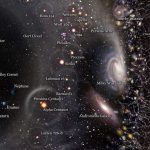For about 50 years, the scientific community has been grappling with a substantial problem: There isn’t enough visible matter in the universe.
Key takeaways
- For decades, scientists have struggled to explain the lack of visible matter in the universe. Dark matter, unseen and not interacting with light, is believed to account for this missing mass.
- American astronomers Vera Rubin and W. Kent Ford confirmed dark matter’s existence in the 1970s by observing stars in spiral galaxies moving too quickly to be held together by visible mass alone.
- Stephen Hawking proposed that dark matter could be composed of primordial black holes formed during the big bang. This hypothesis has gained renewed interest and support from recent studies.
- Researchers at MIT have explored the formation of these primordial black holes, revealing they likely formed in the first quintillionth of a second after the big bang. This timing predates the formation of protons and neutrons.
- The study suggests these primordial black holes could have absorbed free quarks and gluons, making them different from typical black holes formed by collapsing stars. They would be incredibly small, yet could account for much of the universe’s dark matter.
According to NASA, all of the stuff we can see — stars, planets, cosmic dust, and everything in between — cannot explain why the universe operates the way it does, and there must be five times as much of it to make researchers’ discoveries make sense. Scientists call it dark matter because it does not interact with light and is unseen.
Vera Rubin and W. Kent Ford, both American astronomers, verified the presence of dark matter in the 1970s by studying stars circling the edges of spiral galaxies. They saw that these stars were traveling too quickly to be kept together by the galaxy’s observable mass and gravity; they should have been flying apart instead. The only explanation was a significant amount of invisible substance that bound the galaxy together.
Rubin once observed that “what you see in a spiral galaxy is not what you get.” Her research expanded on a concept proposed by Swiss astronomer Fritz Zwicky in the 1930s, kicking off a quest for the elusive element.
Since then, scientists have attempted to view dark matter directly and have even developed huge detectors – but have had no success.
Early in the quest, famed British physicist Stephen Hawking proposed that dark matter may be lurking in black holes, the major topic of his studies, which formed at the big bang.

A recent study by researchers at the Massachusetts Institute of Technology has reintroduced the hypothesis, showing what these primordial black holes were formed of and maybe uncovering an altogether new sort of exotic black hole in the process.
“It was really a wonderful surprise that way,” said David Kaiser, one of the study’s authors.
“We were making use of Stephen Hawking’s famous calculations about black holes, especially his important result about the radiation that black holes emit,” Kaiser told me. “These exotic black holes emerge from trying to address the dark matter problem — they are a byproduct of explaining dark matter.”
The first quintillionth of a second
Scientists have offered several theories on what dark matter may be, ranging from undiscovered particles to other dimensions. However, Hawking’s black hole hypothesis has only recently come into play.
“People didn’t really take it seriously until maybe 10 years ago,” said research co-author and MIT graduate student Elba Alonso-Monsalve. “And that’s because black holes once seemed really elusive — in the early 20th century, people thought they were just a mathematical fun fact, nothing physical.”
We now know that virtually every galaxy has a black hole, and researchers’ discovery of Einstein’s gravitational waves caused by colliding black holes in 2015 – a milestone discovery — demonstrated that they exist everywhere.
“Actually, the universe is teeming with black holes,” Alonso-Monsalve explained. “But the dark matter particle has not been identified, despite the fact that people examined everywhere they anticipated to find it. This is not to suggest that dark matter is not a particle, or that it is invariably black holes. It might be a mix of the two. However, black holes as possibilities for dark matter are currently being studied very seriously.”
Other recent studies have confirmed Hawking’s hypothesis, but Alonso-Monsalve and Kaiser, a physics professor and the Germeshausen Professor of the History of Science at MIT, go one step further by investigating what happened when primordial black holes first formed.
The study, published on June 6 in the journal Physical Review Letters, reveals that these black holes must have appeared in the first quintillionth of a second after the big bang. “That is really early, and a lot earlier than the moment when protons and neutrons, the particles everything is made of, were formed,” Alonso-Monsalve said.
Protons and neutrons cannot be torn apart in our everyday lives, she noted, despite their role as elementary particles. However, we know they are not because they are made up of even smaller particles known as quarks, which are held together by other particles known as gluons.
“You cannot find quarks and gluons alone and free in the universe now, because it is too cold,” said Alonso-Monsalve. “But early in the big bang, when it was extremely hot, they could be found alone and free.” So the primordial black holes were generated by consuming free quarks and gluons.”
Such a creation would set them apart from the astrophysical black holes that scientists often witness in the cosmos, which are caused by collapsing stars. Furthermore, a primordial black hole would be substantially smaller, with the typical mass of an asteroid condensed into the volume of a single atom. However, if a significant number of these primordial black holes did not disappear in the early great bang and lived to this day, they could account for all or most dark matter.
A long-lasting signature
According to the findings, another sort of hitherto undiscovered black hole appeared as a consequence when the primordial black holes were being generated. These would have been much smaller, with the mass of a rhino packed into less than the space of a single proton.
Because of their small size, these miniature black holes might have picked up a unique and exotic attribute from the quark-gluon soup in which they originated, known as a “color charge.” According to Kaiser, it is a state of charge found only in quarks and gluons and never in regular things.
This color charge would distinguish them from black holes, which typically have no charge of any kind. “It’s inevitable that these even smaller black holes would have also formed, as a byproduct (of primordial black holes’ formation),” Alonso-Monsalve advised, “but they would not be around today anymore, as they would have evaporated already.”
However, if they were still around ten millionths of a second into the big bang when protons and neutrons created, they may have left detectable signs by changing the balance between the two particles.
“The balance between how many protons and neutrons were created is quite delicate, and it is determined by what else there in the cosmos at the moment. If these black holes with color charge were still present, they may have changed the balance between protons and neutrons (in favor of one or the other), just enough for us to quantify in the coming years,” she said.
According to Kaiser, the measurement might be made using Earth-based telescopes or sensitive instrumentation aboard orbiting satellites. But there could be another method to establish the presence of these unique black holes, he noted.
“Creating a population of black holes is a violent process that will cause massive vibrations in the surrounding space-time. “Those would be attenuated over cosmic history, but not to zero,” Kaiser explained. “The next generation of gravitational detectors could catch a glimpse of the small-mass black holes — an exotic state of matter that was an unexpected byproduct of the more mundane black holes that could explain dark matter today.”
Many forms of dark matter
What does this mean for the ongoing experiments that are trying to detect dark matter, such as the LZ Dark Matter Experiment in South Dakota?
“The idea that there are exotic new particles remains an interesting hypothesis,” Kaiser said. “There are other kinds of large experiments, some of which are under construction, looking for fancy ways to detect gravitational waves. And those indeed might pick up some of the stray signals from the very violent formation process of primordial black holes.”
Alonso-Monsalve further mentioned that primordial black holes might account for just a portion of dark matter. “It doesn’t really have to be all the same,” she told me. “Dark matter is five times more abundant than ordinary matter, which is composed of a variety of particles. So, why should dark matter be one sort of object?”
“This work is an interesting, viable option for explaining the elusive dark matter,“ Cappelluti said.
Priyamvada Natarajan, the Joseph S. and Sophia S. Fruton Professor of Astronomy and Physics at Yale University, described the work as interesting and proposed a unique process of development for the first generation of black holes. She was also not participating in the study.
“All the hydrogen and helium that we have in our universe today was created in the first three minutes, and if enough of these primordial black holes were around until then, they would have impacted that process and those effects may be detectable,” Natarajan told reporters.


